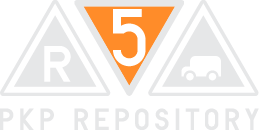Markings of dangerous goods:
- plates/stickers with type of danger:
- explosive (class 1, 1.4, 1.5, 1.6 ),
- flamable gas (class 2.1, two color variants),
- presurized gas (class 2.2, two color variants),
- poisonous gas (class 2.3),
- flamable liquid (class 3),
- flamable solid (class 4.1),
- pyrophoric substance (class 4.2),
- substance discharging flamable gas in contact with water (class 4.3),
- oxidizer (class 5.1),
- organic peroxide (class 5.3, two color variants),
- poisonous substances (class 6.1),
- infectious substance (class 6.2),
- radioactive substance (class 7A, 7B, 7C, 7D, 7E),
- corrosive substance (class 8),
- other dangerous substances (class 9),
- risk of water contamination;
- orange warning plate for vehicles transporting dangerous substances (normal and small);
- ADR plates/stickers with marking of dangerous substance:
- petrol 33/1203,
- ammonia 268/1005,
- natural gas 223/1972,
- methanol 336/1230,
- diesel fuel 30/1202,
- kerosene 30/1268,
- hydrochloric acid 80/1789,
- ammonium nitrate 50/2067,
- blank ADR plate (to be filled with other code);
- large stickers for single piece of cargo:
- danger,
- infectious,
- radiocative,
- poisonous,
- corrosive,
- danger of electric shock,
- heated container;
- railway plates/stickers “shunt carefully”, “run-up and run-onto forbidden”.

Based on:
- Wytyczne postępowania przy przewozie koleją towarów niebezpiecznych, Polskie Koleje Państwowe S.A. Warszawa 2001 r. (from http://kolej.krb.com.pl/, last access 8th January 2015),
- European Agreement concerning the International Carriage of Dangerous Goods by Road, Annex A: General provisions and provisions concerning dangerous substances and articles (from http://www.unece.org/trans/danger/publi/adr/adr2009/09ContentsE.html, last access 8th January 2015).


